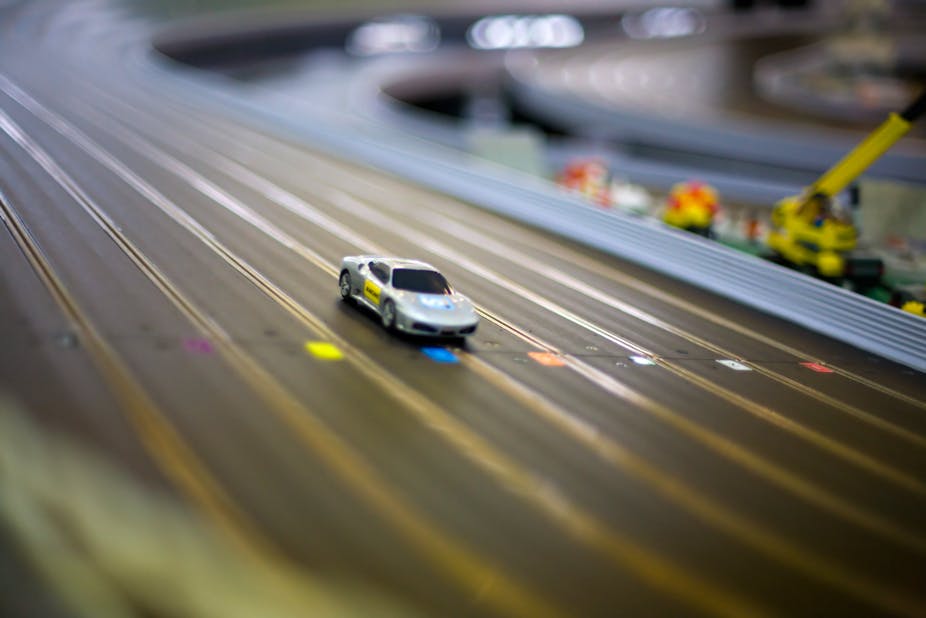It sounds like something from the pages of books from the 1960s looking to the future: electric cars powered by current drawn from electrified rails beneath the road. However possible such ideas seemed to be 50 years ago, they seem fairly fantastical now – and yet it’s exactly this that’s being trialed by Britain’s Highways Agency.
Electric vehicles are key to providing transport for the future while reducing CO2 emissions to a fifth of current levels by 2050. However, with a maximum range of 100 miles many drivers are reluctant to buy one other than as a second car. Without persuading family car buyers and those buying company car fleets, too few electric vehicles will be sold to make any difference.
Many towns and cities have welcomed battery electric buses because of their low noise and pollution. Where range has been a problem, induction coils have been installed under the road at bus stops and in bus stations to recharge them. But does it make sense to use the same technology to charge cars on the motorway, essentially giving electric vehicles indefinite range?
Charging lanes
There would be formidable technical problems. An electric car running at 70mph would require around 20kW, anything less and the battery would discharge, not recharge. To boost the battery level while driving would require at least double the power input. If the idea takes off, at peak times we could see 20 electric vehicles entering the “charging lane” every minute. Taking into account both directions of travel, this would represent an electrical demand of 1 MW/km at 70 mph – roughly equivalent to the electrical demand of 600 houses.
This is a major electrical installation, comparable in scale to the electrical system of a mainline railway. And that’s before we even consider what digging up the M1 – one of Europe’s busiest motorways – would entail in terms of cost and disruption.

The charging systems used by buses check the vehicle is above the coils and then switches on the power. With a procession of electric vehicles on a motorway, there is no straightforward way of switching power for a succession of coils on and off for each car – the power would have to be permanently on. The risk assessment of what happens should a petrol-driven car pull into the charging lane would be “interesting”: petrol tanks are usually steel, presenting a conducting surface directly above the charging coils. Presumably there would also have to be some sort of billing mechanism to calculate the energy drawn by each vehicle and to charge the owner.
Making peak time even peakier
Leaving aside the technological challenges, we have to ask whether an electric motorway is really desirable for the long term. I’ve argued elsewhere that, given high levels of renewable energy and nuclear power, by 2050 the capital costs of building electricity generation infrastructure to cope with peak demand will dominate, while the running costs will be hardly worth calculating.
Similar arguments apply to CO2 emissions – electricity used in winter at peak periods (mornings before and evenings after work) will be at least in part produced by gas turbines. Electricity used at 3am will come from nuclear or renewables. Charging electric vehicles at night effectively provides zero-carbon transport because of how the electricity is generated; charging them during the rush hour on a Scalextric motorway will only require greater use of fossil fuels.
Hybrid electric and freight trains
What are the alternatives to electric cars? Studies over the past 30 years suggest that electric vehicles with a battery capacity of 20kWh can satisfy more than 80% of car users’ needs. In other words, while some journeys require more range than can be provided for by a battery, the majority are short enough – daily commutes, school runs, trips to the shops – that a 20kWh battery would be sufficient. Adding a small petrol or diesel engine, sufficient to maintain average power levels for motorway cruising, gives a plug-in hybrid car that can cope with those 20% of journeys, and in which fossil fuels would be used for less than 20% of mileage.
Although plug-in hybrid technology would work for passenger cars, it’s less suitable for long-distance haulage trucks. The obvious solution is to transfer long-distance freight to the railway – but the current network is already over capacity. Taking the huge volume of commercial haulage off the road would entail building another freight rail network, “containerised” so as to be able to simply load and unload HGV cargo.
What about hydrogen? If we install sufficient wind and solar generation to cope with the winter electricity demand, there will be spare capacity in the summer. Rather than letting this go to waste, it could power electrolysis to produce hydrogen that could be stored to fuel freight vehicles. The technology has been demonstrated on London buses, which as as big as an HGV – why not on HGVs?
Decarbonising transport will require radical engineering solutions. Plug-in hybrids and hydrogen offer approaches that allow demand to be scheduled to match the availability of renewable energy, making it a more attractive investment. We cannot look at individual technologies alone as a single panacea. We must see how they can be used to fit together, pieces of the jigsaw depicting the energy landscape. Looking at it like this, the Scalextric-style approach should be left where it belongs – in the playroom.

